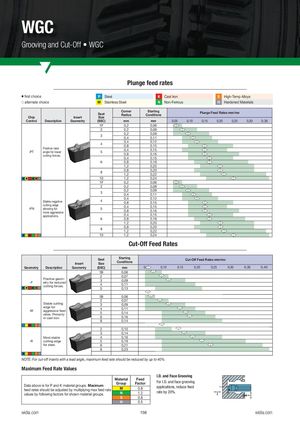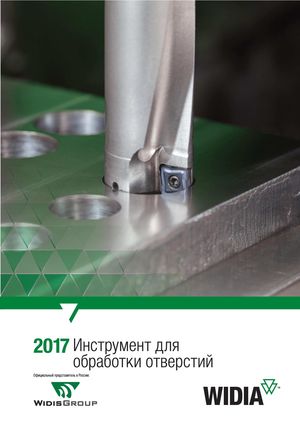Каталог Widia достижения 2020 - страница 160
Навигация
- Table of contents
- All-Star
- Indexable Milling
- VSM890™-12
- VXF™
- VXF-07
- VXF-09
- VXF-12
- VXF-16
- VXF Best practices
- Heavy Metal Extensions
- Solid ER Collets
- VSM
- VSM11
- VSM17
- Solid End Milling
- The VariMill Family
- 70NS
- 4U50 & 4U80
- 4U50
- 4U80
- 49N9
- D503
- General Purpose End Mills
- Holemaking
- TDMX
- Top Cut 4
- Turning
- WGC
- WK15CT
- Railway Tooling
- Bar Peeling
- Informational Icons Guide
- Customer Application Support (CAS)
- Material Overview • DIN

vvvjv vjvj vv vv vv jj WGC Grooving and Cut-Off • WGC Plunge feed rates v first choice P Steel K Cast Iron S High-Temp Alloys j alternate choice M Stainless Steel N Non-Ferrous H Hardened Materials Corner StartingSeatRadiusConditions Plunge Feed Rates mm/rev Chip Insert Size Control Description Geometry (SSC) mm mm 0,05 0,10 0,15 0,20 0,25 0,30 0,35 1F 0,2 0,06 2 0,2 0,08 3 0,20,4 0,090,11 4 0,40,8 0,120,15 Positive rake-PTangle for lowercutting forces.5 0,40,8 0,150,16 0,4 0,15 6 0,8 0,18 1,2 0,20 8 0,81,2 0,200,22 10 1,2 0,24 1F 0,2 0,06 2 0,2 0,08 3 0,20,4 0,090,11 Stable negative 4 0,40,8 0,120,15 cutting edge-PNallowing formore aggressive5 0,40,8 0,150,16 applications. 0,4 0,15 6 0,8 0,18 1,2 0,20 8 0,81,2 0,200,22 10 1,2 0,24 Cut-Off Feed Rates Seat StartingInsertSizeConditions Cut-Off Feed Rates mm/rev Geometry Description Geometry (SSC) mm 0,05 0,10 0,15 0,20 0,25 0,30 0,35 0,40 1B 0,06 2 0,07 Positive geom--Fetry for reducedcutting forces.3 0,0940,11 5 0,13 1B 0,06 2 0,07 Stable cutting 3 0,09 edge for-Maggressive feedrates. Primarily4 0,1150,14 in cast iron. 6 0,16 8 0,14 2 0,10 3 0,14 Most stable 4 0,16 -R cutting edge 5 0,19 for steel. 6 0,21 8 0,23 NOTE: For cut-off inserts with a lead angle, maximum feed rate should be reduced by up to 40%. Maximum Feed Rate Values I.D. and Face Grooving Material FeedData above is for P and K material groups. MaximumGroupFactorfeed rates should be adjusted by multiplying max feed rateM0.8values by following factors for shown material groups.N1.2For I.D. and face groovingapplications, reduce feedrate by 20%. S 0.8 H 0.5 widia.com 158 widia.com
 Каталог Widia инструмент для обработки отверстий 2017
Каталог Widia инструмент для обработки отверстий 2017 Каталог Widia токарный инструмент 2020
Каталог Widia токарный инструмент 2020 Каталог Widia монолитный инструмент 2017
Каталог Widia монолитный инструмент 2017 Каталог Widia техническое руководство по разверткам
Каталог Widia техническое руководство по разверткам Каталог Widia инструментальная оснастка
Каталог Widia инструментальная оснастка